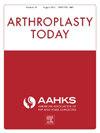股骨颈骨折全髋关节置换术的前路与后路方法
IF 1.5
Q3 ORTHOPEDICS
引用次数: 0
摘要
背景本研究的目的是根据股骨颈骨折全髋关节置换术的手术方式,比较1年后或死亡前的并发症发生率和临床预后。方法本回顾性研究针对2005年至2022年间本院101例移位性股骨颈骨折患者进行。所有手术均由受过研究员培训的关节置换外科医生通过后Kocher-Langenbeck入路、内收疏松前外侧入路或直接前入路进行。结果37名患者采用了直接前方入路,42名患者采用了内收肌疏松前外侧入路,22名患者采用了后方入路,三组患者的人口统计学特征无显著差异。43.3%的患者可以出院回家,而55.4%的患者则被送往亚急性康复中心或其他疗养院。并发症发生率为30.6%,再次手术率为7%,脱位率为0.9%。后路组患者更有可能出院去康复中心而不是回家(82.0%对48.6%,P = .0054),并发症发生率显著增加(P = .04)。结论在我们的系列研究中,股骨颈骨折的前路全髋关节置换术的术后并发症发生率明显降低,输血率降低,出院回家的比例明显提高。本文章由计算机程序翻译,如有差异,请以英文原文为准。
Anterior Versus Posterior Approach for Total Hip Arthroplasty in Femoral Neck Fractures
Background
The purpose of this study was to compare complication rates and clinical outcomes at 1 year or until death based on the surgical approach for total hip replacement in femoral neck fractures.
Methods
This retrospective study was performed on 101 patients with displaced femoral neck fractures at our institution between 2005 and 2022. All surgeries were performed by fellowship-trained arthroplasty surgeons via either a posterior Kocher-Langenbeck approach, an abductor sparing anterolateral approach, or a direct anterior approach. Demographics were collected, as well as intraoperative characteristics, discharge information, and complications.
Results
Thirty-seven patients underwent a direct anterior approach, 42 underwent an abductor sparing anterolateral approach, and 22 underwent a posterior approach, with no significant difference in demographics between the groups. Of patients, 43.3% were able to be discharged home, while 55.4% of patients went to subacute rehab or other nursing home facility. There was a 30.6% complication rate, a 7% reoperation rate, and a 0.9% dislocation rate. The posterior group was more likely to be discharged to rehab instead of home (82.0% compared to 48.6%, P = .0054) and had a significant increase in complication rate (P = .04). There was a 36.3% rate of transfusion in the posterior group compared to a 5.0% rate in the anterior group (P < .0001).
Conclusions
Anterior-based total hip arthroplasty for femoral neck fractures in our series demonstrated a significantly lower rate of postoperative complications, a lower rate of transfusion, and a significantly higher rate of being discharged home.
Level of Evidence
Level III.
求助全文
通过发布文献求助,成功后即可免费获取论文全文。
去求助
来源期刊

Arthroplasty Today
Medicine-Surgery
CiteScore
2.90
自引率
0.00%
发文量
258
审稿时长
40 weeks
期刊介绍:
Arthroplasty Today is a companion journal to the Journal of Arthroplasty. The journal Arthroplasty Today brings together the clinical and scientific foundations for joint replacement of the hip and knee in an open-access, online format. Arthroplasty Today solicits manuscripts of the highest quality from all areas of scientific endeavor that relate to joint replacement or the treatment of its complications, including those dealing with patient outcomes, economic and policy issues, prosthetic design, biomechanics, biomaterials, and biologic response to arthroplasty. The journal focuses on case reports. It is the purpose of Arthroplasty Today to present material to practicing orthopaedic surgeons that will keep them abreast of developments in the field, prove useful in the care of patients, and aid in understanding the scientific foundation of this subspecialty area of joint replacement. The international members of the Editorial Board provide a worldwide perspective for the journal''s area of interest. Their participation ensures that each issue of Arthroplasty Today provides the reader with timely, peer-reviewed articles of the highest quality.
 求助内容:
求助内容: 应助结果提醒方式:
应助结果提醒方式:


